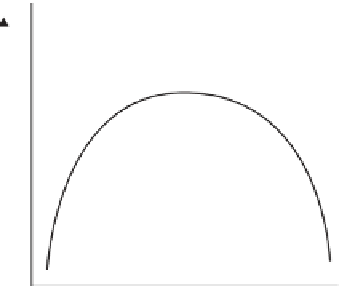Agriculture Reference
In-Depth Information
Aridity
Productivity
Fig. 8.7
Relationships between fire frequency, productivity and aridity (from Pausas & Bradstock
2007). The range of MTV is indicated by the solid line and the approximate order of differing
communities is indicated. The stippled area represents the domain of dominance by cool
temperate rainforest
.
scale), as predicted by Huston (
2003
)? Does such fire regime heterogeneity
reinforce the patterns of varying functional type abundance across habitats?
Fuel Systems, Fire Weather and Flammability
MTV fuel structure leads to very different fire regimes and is determined by
several elements. Where shrubs and trees dominate, litter fuels from woody plants
are the primary determinant of ignition and fire spread potential, whereas in
herbaceous-dominated communities standing dead grasses and forbs are the
primary fuel. At the wet end of the MTV spectrum (
Fig. 8.7
) in graminoid-
dominated wet heaths, fire spreads in herbaceous surface fuels with passive crown
fires of individual shrubs. At the dry end, in woodland communities herbaceous
perennial and annual grasses are similarly important in fire spread. Moisture
therefore plays a role in community flammability and patterns of fire spread. In
many Australian ecosystems, flammability is heavily affected by the extraordin-
arily high flammability of eucalypts.
Variations in eucalypt density directly affect ignitability, rate of spread and fire
intensity via the spatial continuity and loading of their litter fuels (Catchpole
2002
). In woodlands with high densities and greater than 20% canopy cover,
eucalypts create a continuous layer of surface litter that is readily ignitable and
highly combustible due to its bulk density and energy content. These fuels repre-
sent a substantially higher fire hazard than litter produced by other perennial
sclerophyllous taxa, particularly those with narrow, needle leaves or other vegeta-
tion such as rainforest (Dickinson & Kirkpatrick
1985
; Bradstock & Gill
1993
;
Scarff & Westoby
2006
; Plucinski & Anderson
2008
). Surface loadings of litter,




















































